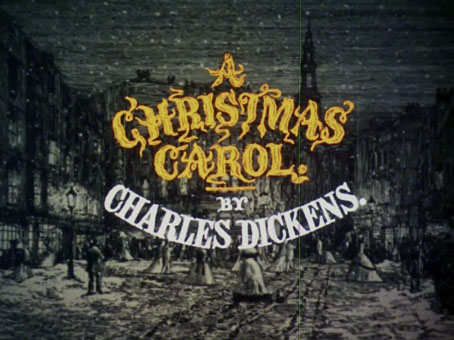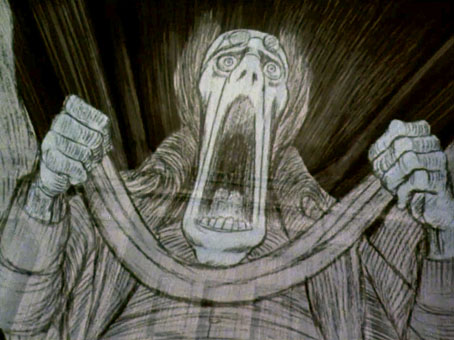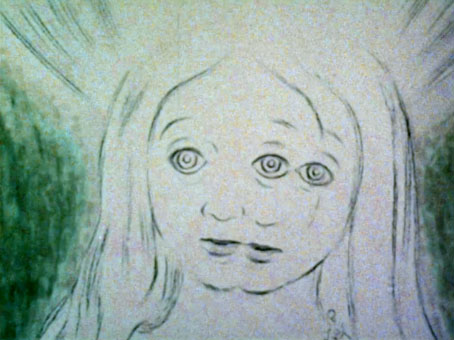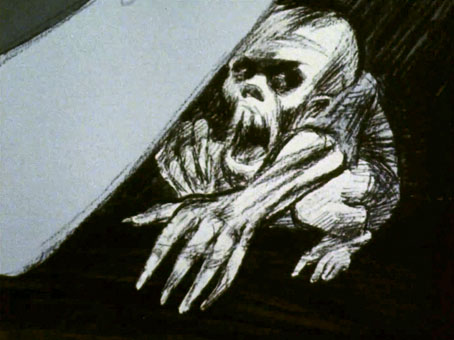
It’s easy to loathe the teeth-grinding sentimentality of Charles Dickens’ seasonal tale, as well as its subtext which isn’t so far removed from Emperor Ming’s instruction to his cowed populace in Flash Gordon: “All creatures shall make merry…under pain of death.” Yet as a ghost story I prefer A Christmas Carol to the sketchier The Signal-Man, and I’ve always enjoyed this memorable 1971 adaptation from the animation studio of the great Richard Williams.

Marley’s ghost.
Williams is best known today for his role as animation director on Who Framed Roger Rabbit? but prior to this he’d distinguished himself as creator of the florid title sequence for What’s New, Pussycat? (1965), and the animated sections—done in the style of 19th-century engravings and political cartoons—for Tony Richardson’s The Charge of the Light Brigade (1968). Williams’ Christmas Carol owes a similar debt to Victorian graphics, not only to the original story illustrations by John Leech, but also to Gustave Doré’s views of Victorian London, scenes which had earlier influenced the production design for David Lean’s adaptation of Oliver Twist. Williams’ film crams Dickens’ story into 25 minutes but nonetheless manages to maintain the tone of the original to a degree which eludes many feature-length travesties, especially those in which the nightmare squalor of Victorian London is reduced to a shot or two of dressed-down extras. Dickens had first-hand experience of the squalor: Kellow Chesney’s The Victorian Underworld (1970) quotes at length from one of the journeys Dickens took (under police escort) through the notorious St Giles rookery, and his ghost story was intended as much as a warning to the complacency of middle-class Victorian readers as a Christmas celebration.

The Ghost of Christmas Past.
For me the crucial moment in any adaptation comes when the Ghost of Christmas Present shows Scrooge the figures of Ignorance and Want: in most film versions these tend to be a pair of well-fed child actors in rags and make-up; Williams shows us two grim spectres that owe more to Gerald Scarfe than Walt Disney. Williams is also truer to the ghosts themselves: Dickens describes Jacob Marley unfastening his jaw which falls open then remains that way while he proceeds to speak to his former friend; the Ghost of Christmas Past is the androgynous figure from the story with its ambiguous nature also shown by its shimmering indeterminate outline.

Ignorance.
Any animated drama relies on its voice actors, and Williams was fortunate to have Alistair Sim (as Scrooge) and Michael Hordern (as Marley) reprising their roles from the 1951 film version, while Michael Redgrave narrates the tale. The film used to be a seasonal fixture of British television, and may still be for all I know (I haven’t owned a TV for years). For the time being it’s on YouTube, of course, with a full-length version here that’s blighted by compression artefacts but is watchable enough. 2012 is the Dickens bicentenary so expect to hear a lot more about the author and his works in the coming year.
Update: The version linked to originally has been deleted. No matter, there’s a much better copy here (for now).
As usual I’ll be away for a few days so the { feuilleton } archive feature will be activated to summon posts from the past below this. Have a good one. And Gruß vom Krampus!
Previously on { feuilleton }
• “Who is this who is coming?”

A very merry whatever to you!
Thanks for shedding a bit of light on a distinct talent (which i suppose is one of the main objectives of this blog). The animated sequences from Charge of the Light Brigade have remained in my head for years so it’s great to put a name to the work. Kudos to you for not having a tv, I really hope I reach that point some time in the future. All the best and good will for the coming days, whatever you want to hang that on, I can picture you burning a wicker man style effigy in your front lawn tomorrow
the film is free on google vids: http://video.google.com/videoplay?docid=-8817517652455175582
Great post. I am 100% in agreement with you on the merits of Richard Williams’s film, which won an Academy Award for best animated short. I’m glad you point out the crucial importance of the scene with the children Ignorance and Want, which is so central to Dickens’s vision. Although the narrative pace of this half-hour film is necessarily a bit brisk, Williams’s quick transitions actually reinforce the dream-nature of the story, which many adaptations altogether fail to capture. Williams takes full advantage of what animation can do in the bravura sequence of the Ghost of Christmas Present revealing holiday cheer in remote and humble locations – a coal-mine, a working ship at sea – before transporting Scrooge back to London.
Great work,thanks!
When I was a lad in L.A., I happened to see this show one time on the television at my parents’ home, probably near to when it first came out. I never was able to see it again, or to find it, as apparently it never gained favor among the powers-that-be in Hollywood. Nonetheless, the beauty of this work struck me, and the images of Ignorance and Want (particularly the silent, daemonic yowl of the former Child) remained deeply graved in my memory.
Later, when I gathered such bits as could be found on prime-time TV, like the Alistair Sim black and white A Christmas Carol, I knew that something in it resonated as being particularly beautiful, but without knowing quite why.
Thank you, John, for filling in one of the lacunae in my life. This is one of the things that I have been trying to find for decades.
Thanks, everyone.
Alfie: I didn’t want to stray from the point too much so I didn’t mention Williams’ sadly incomplete magnum opus The Thief and the Cobbler.
Patrick: Until I rewatched this I’d forgotten about the lighting-fast transitions, another benefit of using animation.
Bernard: Thanks for that. Every so often I’ll think “Surely everyone knows all about this?” and feel tempted to avoid a topic as a result. It’s good to be reminded that this isn’t always the case.
John,
Wishing in some way to thank you further for your great kindness in informing me of Richard Williams’ Christmas Carol, and knowing of your all-consuming interest in matters visual, I wondered whether you were aware of The Animators’ Survival Kit, by Richard Williams. I happened to find it as a coffee table book at the home of two college friends when they had the great kindness to invite and to fly me and my wife (at their expense) from L.A. to Seattle last week.
The book is a marvelous precis of the history of classic animation, and is more of a grimoire and somewhat of a ‘how-to’ book as to the process of animation. It is also very well written, and as is stuffed with wit and good humor as a Christmas goose is with bread stuffing. Finally, the book shows something of how Williams’ did the work for his Christmas Carol.
While I dare say that you could buy the thing used on Amazon, I have found a scribd site where you can read it freely, and for free. Here it is:
http://www.scribd.com/doc/5445343/the-animators-survival-kit-richard-williams
Wishing you both a belated Epiphany and a Gruß vom Krampus as well, I am,
Very truly yours,
Bernard Brandt
Thanks, Bernard, I did know about that book from the Charge of the Light Brigade DVD where the booklet has a page of rather redundant stills and nothing more from Williams. I’m tempted to track down a copy of the book, I’ve always been fascinated by animation (hence this post), and have a short documentary piece about RW on tape somewhere that was screened when Who Framed Roger Rabbit? came out. Williams and co. are of interest for their ability to vary their style according to subject, from stylised cartoons like the Pink Panther titles, to very realistic pencil renderings.